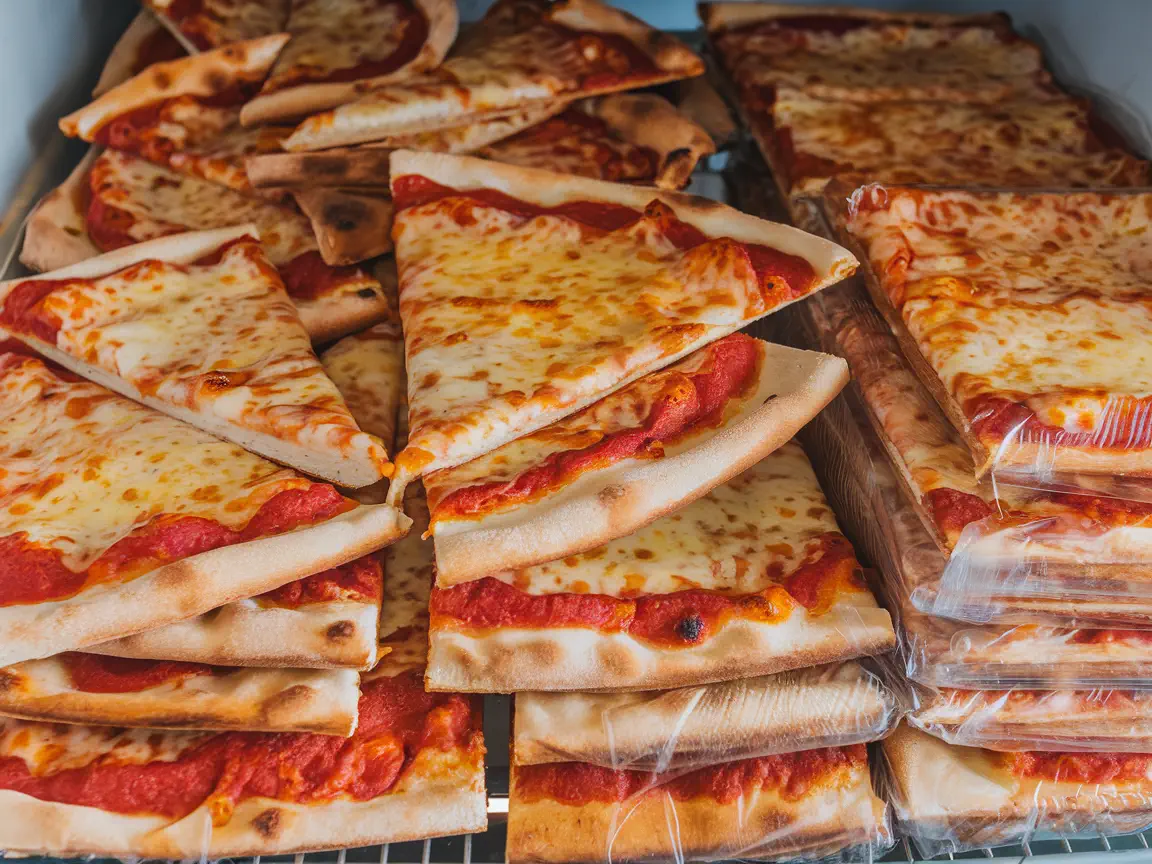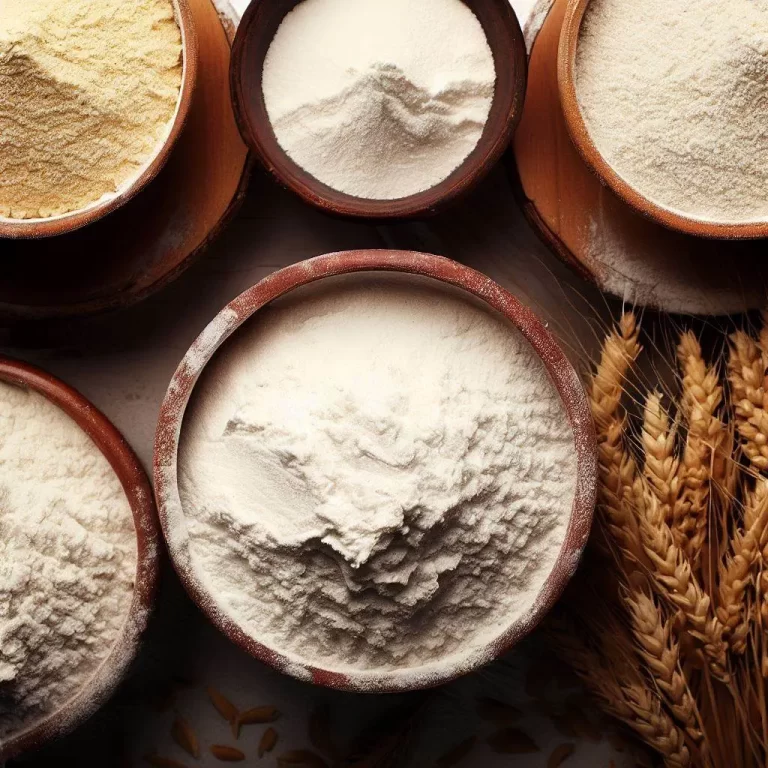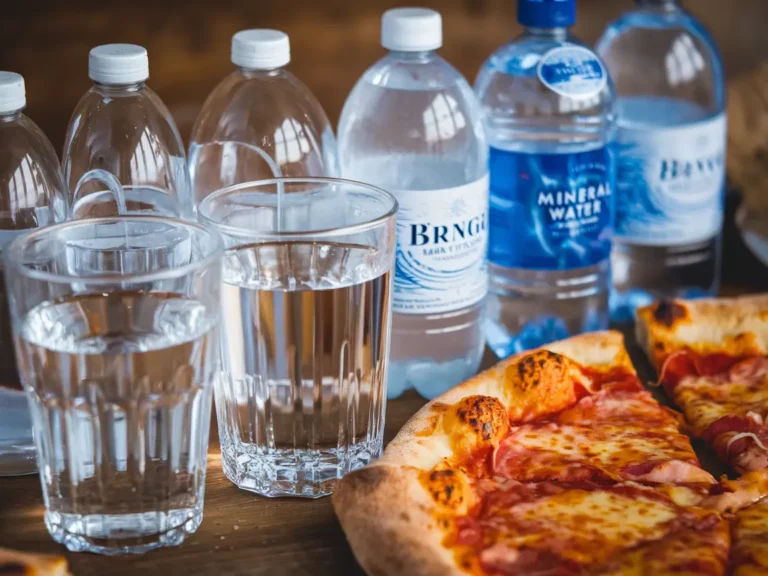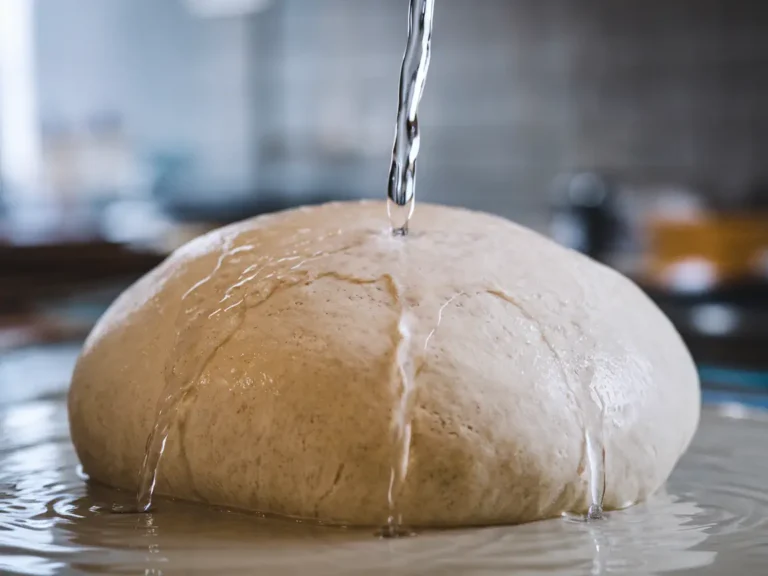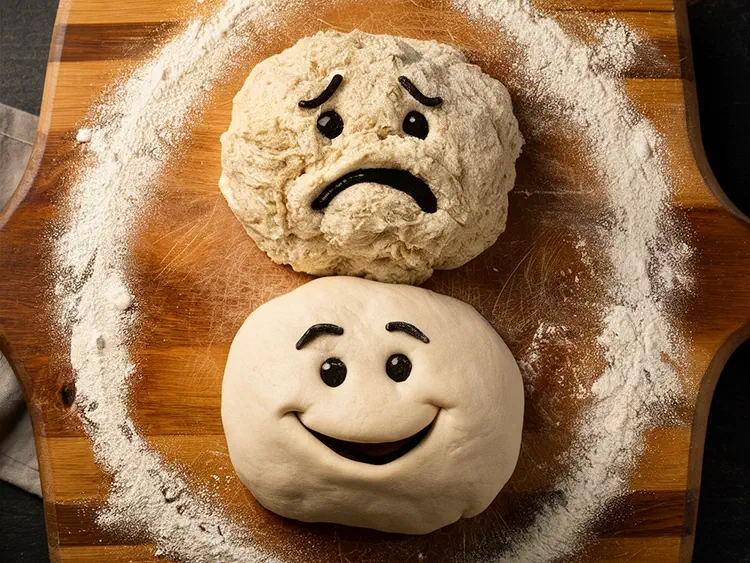Best Way to Store and Freeze Pizza [Leftover Slices or Whole Pies]
What is the best way to store pizza, whether whole or in individual slices? In this article, we’ll learn how to store pizza to best preserve its quality and freshness, as well as the proper method for freezing a whole pizza that’s specifically intended for freezing
Introduction: How Storage Conditions Affect Pizza Quality
Storing leftover pizza may seem simple, but the method you choose significantly impacts how well it retains its quality.
From the moment a baked pizza comes out of the oven, ongoing processes begin to affect its texture and overall eating qualities. One of the most important of these is starch retrogradation, the primary cause of baked goods becoming tough and ‘dry’ over time.
Starch retrogradation causes a loss of softness and freshness during storage; In other words, it’s the process that makes baked goods containing flour (starch), including pizza, go stale.
You can learn more about starch retrogradation and other factors that cause baked goods to lose their freshness after baking in the article Why Pizza Becomes Tough When It Cools and How to Preserve Its Freshness [What Makes Baked Goods Go Stale].
Storage conditions directly influence starch retrogradation, determining how well pizza maintains its softness and texture. In the following sections, we’ll explore how different storage methods affect starch retrogradation, and how to minimize it to preserve the pizza’s freshness.
The following information applies to all types of baked goods, not just pizza.
Storage Temperature
The storage temperature plays a crucial role in the rate of starch retrogradation and how well the pizza retains its freshness.
At low temperatures above freezing (0°C/32°F), retrogradation accelerates, due to chemical changes that promote the crystallization of starch molecules. This leads to the dough staling faster and losing its softness and freshness.
The “ideal” temperature for retrogradation to occur at the fastest rate is between 0-5°C (32-41°F), which is the standard refrigerator temperature.
In simple terms: storing pizza (or any baked good containing flour) in the fridge, speeds up retrogradation, causing it to stale and lose its softness the fastest. Thus, refrigerating pizza is the least favorable option, as it promotes rapid staling.
On the other hand, freezing pizza at -18°C (0°F) or lower, halts the retrogradation process. At these temperatures, water molecules “lock” in place, effectively freezing the retrogradation process – quite literally. In summary: freezing halts the retrogradation process.
Storage Conditions (Humidity and Air Exposure)
Storing pizza in a very dry environment, or leaving it uncovered, exposes it to greater moisture loss. Since moisture content affects the rate of retrogradation, faster drying accelerates this process, leading to quicker staling and loss of texture.
On the other hand, storing pizza in a less dry or even humid environment, as well as covering it or placing it in an airtight container to minimize air contact, will help slow down moisture loss, and consequently – slow down retrogradation.
It’s important to note that moisture loss itself doesn’t directly cause baked goods to lose their freshness and softness. Retrogradation is the primary cause of staling and the resulting “dry” texture, while moisture loss indirectly accelerates this process. A decrease in moisture content leads to faster retrogradation, contributing to the toughening and loss of softness in baked goods.
Even under optimal storage conditions, where moisture loss is minimized, baked goods will eventually go stale and lose their softness due to retrogradation. In fact, fresh bread and stale bread that has become tough and “dry”, often have very similar moisture contents, despite their differing textures.
What’s the Best Way to Store Pizza Leftovers
First, avoid storing pizza in the fridge. The temperature in the fridge (about 4°C/40°F) is where retrogradation occurs at the fastest rate.
Below are guidelines for maximizing pizza freshness based on the storage duration, from very short to long periods.
The following guidelines apply to any baked goods that contain flour, not just pizza.
Very Short-Term Storage (Minutes to Hours)
If you need to keep a baked or reheated pizza warm for a short period (from minutes to a few hours, for example, for a future dinner or party), you can leave it in an oven set to 60°C (140°F), with a conventional baking setting (no convection/fan). This temperature prevents retrogradation, helping the pizza maintain its texture until served.
Avoid keeping the pizza in an oven that is too hot, as this will cause it to continue baking. Additionally, this method applies only to pizza that has already been baked or reheated – preventing retrogradation requires that the interior has reached 60°C (140°F), through initial baking or reheating.
Short-Term Storage (Hours to 1 Day)
For short-term storage (such as keeping leftovers for the next day), place the pizza in an airtight container or wrap it in a plastic bag/wrap, in order to minimize moisture loss.
Store it at room temperature, ideally between 20-25°C (68-77°F). When ready to eat, reheat the pizza as usual, or enjoy it at room temperature.
The above temperature range helps slow down retrogradation, and best preserves texture and flavor. Higher temperatures can lead to accelerated moisture loss and bacterial growth, while lower temperatures can speed up retrogradation.
Long-Term Storage (2 Days or More)
For long-term storage, wrap individual slices (or a whole pizza) tightly in plastic wrap, and place them in the freezer.
The freezer temperature prevents retrogradation, ensuring the pizza keeps best over time.
For the best results, transfer the pizza to the freezer as soon as possible after it has completely cooled. Freezing halts further retrogradation, but does not reverse any retrogradation that has already occurred since the pizza was removed from the oven.
Summary: How to Store Pizza
In summary, to best preserve the freshness of your leftover pizza:
- Place in an oven set to 60°C (140°F) for short-term use (minutes to a couple of hours).
- Cover and store at room temperature for short-term use (up to 1 day).
- Freeze for long-term use (1 day or more).
Under no circumstances should you store the pizza in the fridge, as this will cause it to stale the fastest.
How to Freeze a Whole Pizza
Freezing a whole pizza lets you prepare a ready-to-use pizza meal with minimal time and effort – simply take it out of the freezer and place it in the oven; Just like store-bought frozen pizzas – except this one is homemade.
This method is especially useful when you have leftover dough at the end of a pizza night: Instead of freezing fully fermented dough balls, which is generally not recommended, you can prepare and freeze pizzas for future use.
This approach offers several key advantages:
- Efficiency: The oven is already running, and all your pizza-making equipment is set up. Freezing a finished pizza saves you the time and effort of preparing a pizza again from frozen dough.
- Convenience: The frozen pizza is ready to use – just heat it in the oven, with no additional prep required.
- Better Quality: A properly frozen, fully baked pizza retains much better quality than baking improperly frozen dough (see the article linked above).
Two Methods for Freezing a Whole Pizza
A whole pizza can be frozen using two methods:
- Regular baking: Bake the pizza as usual, then let it cool before freezing.
- Partial baking (par-baking): Bake the pizza base just until it is fully set but not browned. Let it cool, then freeze it with or without sauce, cheese, and toppings.
For pizzas intended for freezing, I recommend par-baking. This method typically yields the best results for frozen pizza, which is why it’s commonly used by frozen pizza manufacturers: the pizza base is partially baked, toppings are added, and the final baking is completed at home.
Freezing After Regular Baking
This is the simplest method for freezing a whole pizza:
- Bake: Bake the pizza as usual, without any special adjustments.
- Allow to cool: Allow it to cool completely.
- Wrap tightly: Wrap the cooled pizza tightly in plastic wrap to prevent freezer burn.
- Freeze: Transfer the pizza to the freezer, ensuring it rests on a flat surface to prevent it from freezing in a warped or misshapen form (e.g., if it was bent, it will freeze that way).
If you don’t have enough freezer space for a whole pizza, you can cut it into halves or quarters to save room.
Freezing After Par-Baking (Including Par-Bake Instructions)
Follow these steps to bake and freeze a par-baked pizza:
1. Assemble the pizza: Stretch the dough as usual and add a thin layer of sauce. The sauce helps prevent bubbles from forming during baking. Alternatively, you can dock the dough using a dough docker or a fork.
2. Par-bake: Bake the dough just until it sets, stopping before significant browning occurs. The dough should be firm and fully baked inside, with only the browning stage remaining for the final bake. This typically takes 50–70% of the standard baking time for a “regular” pizza (for example, if you usually bake for 7 minutes, aim for about a 4–5 minute bake).
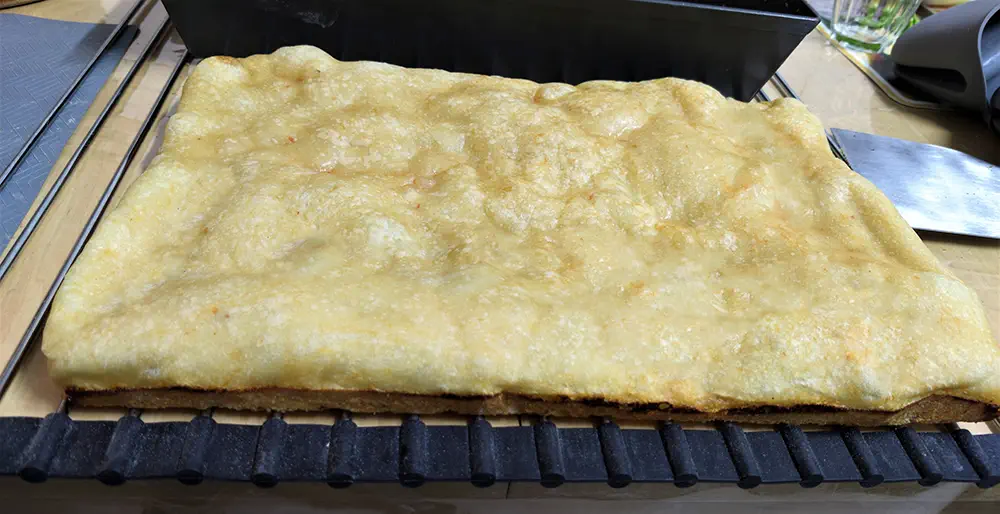
3. Cool the par-baked pizza base: Remove the pizza base from the oven and place it on a raised surface that allows steam to escape from the bottom without making it soggy. Let it cool completely.
4. Assemble the pizza before freezing: Once the base has cooled, you have two options:
- Add the sauce, cheese, and toppings now: This allows for an effortless final bake straight from the freezer.
- Freeze the base “naked”: You can add the sauce, cheese, and toppings when you’re ready to bake, allowing for ‘fresher’ ingredients.
Alternatively, you can make a plain cheese pizza as a base by adding only sauce and cheese, then add additional toppings before the final bake.
Avoid freezing toppings with high moisture content, such as mushrooms, onions, tomatoes, and peppers. These release excess moisture when baked from frozen, potentially creating a soggy pizza. Instead, add them just before the final bake.
5. Freeze the pizza: Wrap the pizza tightly in plastic wrap and transfer it to the freezer. Make sure it rests on a flat surface to prevent it from freezing in a warped or misshapen form (e.g., if bent, it will freeze that way).
How to Reheat Leftover Pizza
For detailed instructions on reheating pizza, whether leftover or par-baked, see How to Reheat Pizza: Best Way to Reheat Explained [A Practical Guide to Perfect Leftovers].
Enjoy the content on PizzaBlab? Help me keep the oven running!

